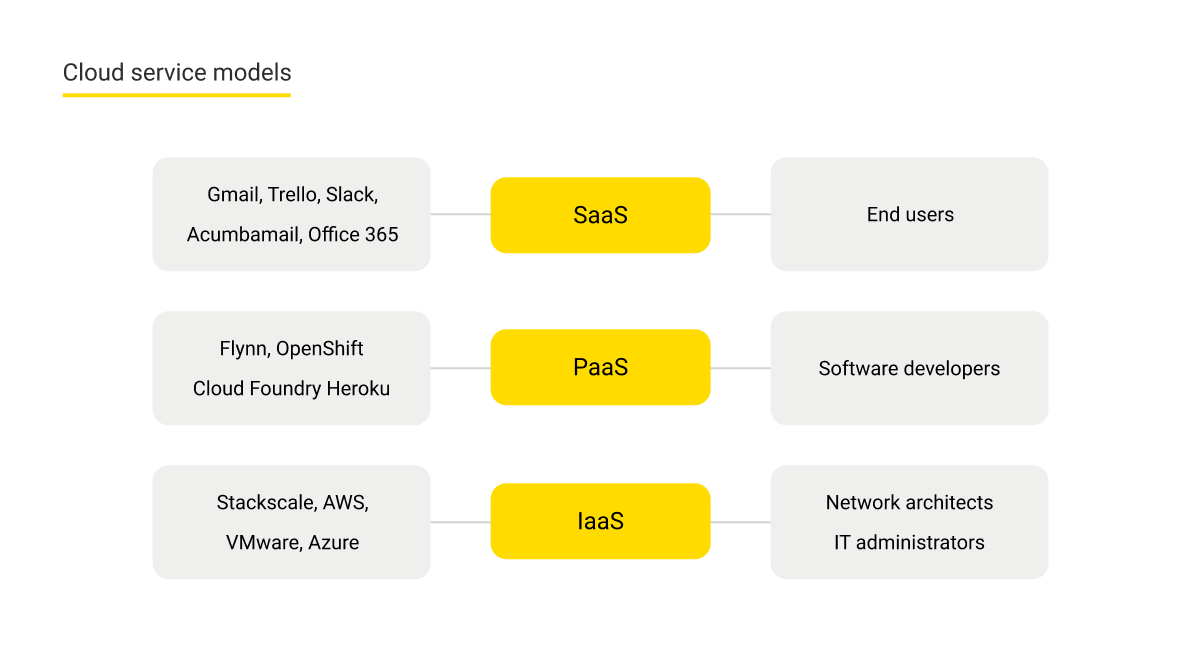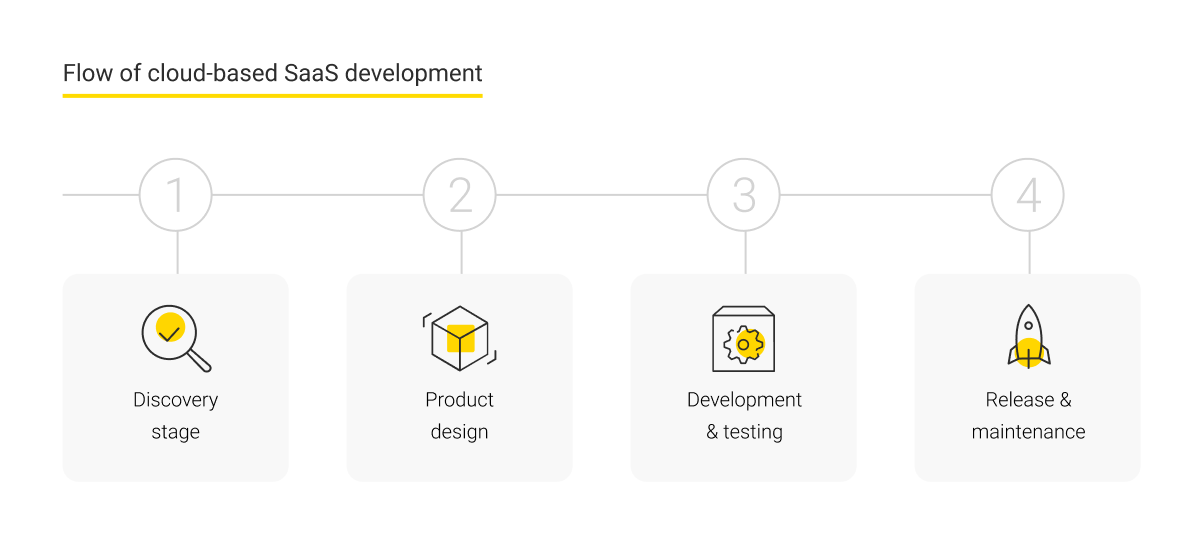- What is cloud application development all about?
- Common cloud application models and how they differ
- Benefits of developing cloud-based apps
- Challenges of cloud application development
- The key steps of cloud-based application development
- Conclusion
As a world-class IT company employing high-end cloud application developers, Andersen closely monitors all the important trends taking place in the cloud. That is to say, we are fully aware of the fact that we are living in a connected, mobile-first, and data-driven world. Hence, to succeed, we should exceed all our customers’ expectations whenever it comes to cloud application services. Today, we have decided to dive more deeply into this important domain.
To begin with, by around 2025, there will be roughly 100 zettabytes of info stored in the cloud. Is that a lot? Well, as a zettabyte equals a trillion gigabytes, it is! Simultaneously, the share of cloud-based apps is also going to reach record heights. For instance, the cloud application market size is projected to reach $168.6 billion. To put this into perspective, back in 2021, it was only $133.6 billion. On top of that, all those enormous volumes of data and investments are associated with high-value corporate databases, not with ordinary users. Among other things, as of 2022, approximately 60% of corporate info, taken together, is stored in the cloud. In 2015, it was only 30%. Thus, the issue of cloud application development should be prioritized.
What is cloud application development all about?
What is a cloud-based app? As Business Insider puts it simply (and rightly), it is a Net-based program, which, at least to some extent, relies on processing and storing some of its data via the Internet. In fact, that is what we call ‘the cloud’, i.e. the Global Net. As Investopedia puts it, ‘the cloud’ might cover ‘storage, servers, databases, networking, and software.’ Thus, cloud-based apps rely on remote databases and cloud computing, not on proprietary hardware or local storage.
Why do people and companies opt for cloud-based solutions, with all the associated risks, e.g. like entrusting your data to an external party?
As TechTarget puts it, the advantages are as follows:
- Cloud applications are almost instantly available and can quickly respond to your business needs in terms of ordering, deploying, and applying them;
- Cloud-based apps offer you the ability to benefit from simplified operations as they are normally easy-to-use and master. Simultaneously, you are not the one responsible for maintaining them and troubleshooting;
- When you realize that you need new features, cloud solutions can be quickly scaled up, as all you need to do is to start paying for a more advanced pricing plan;
- Abundance of APIs for easier adoption and usage;
- Optimized costs, as end-users do not need to spend money on developing, testing, deploying, maintaining, and upgrading the software they use;
- Advanced capabilities in terms of data sharing and transfer;
Owing to these pros, cloud-based service providers have become a fact of life in almost every country. For instance, the following list of top ten cloud vendors, as of 2021, speaks for itself:
- Microsoft;
- Salesforce;
- Oracle;
- SAP;
- Adobe;
- ServiceNow;
- Workday;
- Intuit;
- Zoom;
- UKG.
Common cloud application models and how they differ
There are several approaches to cloud-based solutions in existence. However, they are easily distinguishable from each other on the basis of classes and purposes.
- For regular end-users, with no special tech knowledge, the only applicable type is SaaS (Software-as-a-Service). Within this framework, an application is ‘fueled’ by the vendor’s infrastructure. Users are granted subscription-based access to it to resolve various tasks, such as video conferencing (Zoom), project management (Trello), documents (Google Docs), etc.
- Infrastructure-as-a-service offerings, abbreviated as IaaS, are used by system admins and networks architects as an alternative to costly in-house infrastructures. By ordering them, companies obtain enough storage, advanced server infrastructures, and hardware to process their data. The most well-known example of this class is AWS, a partner of choice for countless companies around the globe.
- Finally, Platform-as-a-Service solutions, aka PaaS, are intended for software engineers requiring pre-configured environments to build and deploy their own solutions. As such, these ecosystems may include systems to manage databases, web-based servers, backup solutions, etc.

Another important classification is focused on how exactly cloud computing is executed:
- Public cloud solutions are available to any legitimate customer and are universally accessible on the Net;
- Private cloud solutions are provided exclusively for your company and use dedicated infrastructure;
- Hybrid cloud solutions include those relying on both private and public clouds.
Benefits of developing cloud-based apps
Whatever your rationale behind cloud application development might be, you are likely to be fully aware of the multiple business advantages it offers. Indeed, cloud application services do offer a range of significant benefits. As a developer and vendor, you can capitalize on:
- Inherent scalability. By adopting a cloud-based approach, you invest in a project that can progressively grow and evolve, together with your resources, end-users, and their needs;
- Global market potential. The essence of cloud-based solutions is that they can be used by end-users regardless of their location. All one has to do to enhance that global availability is to add several major language options to it;
- Low entry barriers. As cloud-based solutions are normally easy to master, you can win more and more customers;
- Flexibility and cost-efficiency. As a cloud app solution provider, you can offer several targeted and affordable pricing plans for various tiers, so that you can effectively cover every relevant client segment.
Challenges of cloud application development
While cloud application development projects are definitely a lucrative option for your investments and efforts, such projects do pose some challenges.
- To begin with, data privacy and security are of particular importance as enormous volumes of sensitive information are, by definition, hosted and processed by the cloud;
- Even and well-balanced allocation of cloud resources in terms of data centers which are capable of handling the peak loads;
- According to TechRepublic, 86% of enterprises are pursuing a multi-cloud strategy. Hence, the solution you are planning to offer to them should be compatible with its likely ‘neighbors’ in terms of multi-platform support;
- Keeping your promises in terms of scalability. From the very outset, your solution has to rely on microservices architecture. At the same time, it should not be overcomplicated. Striking the right balance is a key to your future success.
The best way to resolve these challenges is to collaborate with a trusted and flexible custom software development company running a pool of highly-qualified cloud application developers, such as Andersen. We are in the right position to assume responsibility for your cloud initiative, be it an MVP or an enterprise-grade cloud ecosystem.
Below, you can see the approximate plan we will follow to get things done for you.
The key steps of cloud-based application development
Within our end-to-end framework, Andersen will:
-
Carry out the initial stage of your tech and business requirements specification. While you may have some assumptions, such a session is still an important step, as they are to be tested and scrutinized. This will give you project estimates, a comprehensive list of features and capabilities, tech stacks, and team profiles.
-
Design and Development. Once the preparations are over, Andersen’s UI/UX designers and cloud application developers will start working both on the Back-end and Front-end of your solutions in full conformity with the requirements specifications. On top of that, being an Agile company, we are always ready to alter some things on the go, if an urgent need arises.
-
Testing. Andersen’s QA specialists are known for their attention to detail and proactivity. They will make sure your cloud app will be both secure, crash-proof, and capable of processing the peak number of queries.
-
Deployment and maintenance. The Andersen team views itself as a strategic partner able not only to safely navigate your cloud application though the deployment stage, but also to assume responsibility for support and maintenance.

Conclusion
In spite of the fact that cloud application development projects imply difficulties and tech challenges, the cloud approach is still a great direction to go. We live in a world of remote access, mobile-first behavior, and total connectivity. In this environment, cloud application services offer more pros than cons. So if you get in touch with a trusted team of cloud application developers, such as Andersen, you will be able to capitalize on this trend. By applying our hands-on experience and knowledge of the cloud landscape and best industry practices, we will definitely help you achieve your ambitious goals. Request a free consultation with Andersen today.







